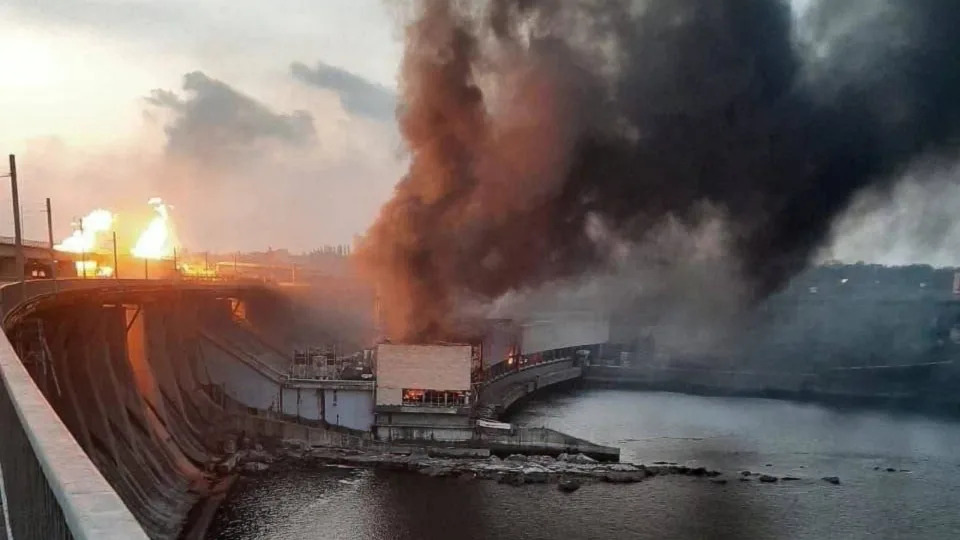Salon – Opinion
Lost in the malignant normality of the Trumpocene
Chauncey DeVega – March 21, 2024

The Trumpocene is not normal. If you accept that it is normal or otherwise become habituated to it, the neofascists and other enemies of democracy have won.
For at least the last eight years I have been writing several times a week about the rise of Trumpism and the deep cultural and societal rot that birthed the monstrosity. I view this work as a type of chronicle, an ongoing account of America’s surreal misadventure. As Hannah Arendt and other truth-tellers have shown, fascism and other forms of authoritarianism are an assault on reality, the facts, and the very idea of the truth. Chronicling and otherwise documenting these events and their meaning is a way of trying to ensure that the facts are preserved, as public memory is under assault and organized forgetting spreads rapidly.
On this, Arendt famously warned, “the ideal subject of a totalitarian state is not the convinced Nazi or Communist, but people for whom the distinction between fact and fiction (that is, the reality of experience) and the distinction between true and false (that is, the standards of thought) no longer exist.”
Chronicling the Trumpocene and America’s democracy crisis and other struggles in this era is also a type of witnessing, which means not just recording the facts but testifying and feeling the pain of others. As psychohistorian Robert Jay Lifton teaches, “One bears witness by taking in the situation — in this case, its malignant nature — and then telling one’s story about it, in this case with the help of professional knowledge, so that we add perspective on what’s wrong, rather than being servants of the powers responsible for the malignant normality. We must be people with a conscience in a very fundamental way.”
It is not just those of us with a public platform who should be carefully chronicling and documenting the Trumpocene and these aberrant events. Everyone who claims to care about democracy and a free society should be doing the same thing. Moreover, this should be done not just online or in some other digital form but in print. The digital is so ephemeral and can easily be disappeared or otherwise altered. Paper is much more real and permanent — and thus dangerous. That is why fascists and other enemies of truth and democracy censor and burn books.
When reality and truth are under siege, doing this type of intellectual and spiritual work is a way to remain sane. As I tell many of the people who reach out to me about escaping the Trumpocene nightmare and who feel exhausted and confused, “You are not crazy, the Trumpocene (and late capitalism, the culture of cruelty, pandemic politics and trauma, environmental collapse, and future shock etc. etc.) is just making you feel that way.”
During the Trumpocene there have been many days when I feel like Charleston Heston in “Planet of the Apes” screaming “It’s a Madhouse!” or Peter Finch as Howard Beale in “Network” bellowing, “I’m as mad as hell and I’m not going to take this anymore!” And there have also been moments, especially as I watch Trumpism nakedly morph into some version of American Hitlerism where I truly wonder if I am Peter Weller in David Cronenberg’s film “Naked Lunch,” and if I have been exposed to that damn “bug powder.”
I know I am not alone in these feelings.
But I realized some months ago that I had made a fundamental error in my assumptions and method in how I have been chronicling these very bad times. The Trumpocene, like other forms of fascism and such malign forces do not exist in a finite space or in a linear relationship to time; it and they really have no concrete beginning and/or end. Such political formations are a type of force that is like a book or story that continues to have chapters added to it in real time. The challenge then, is how to document and intervene against such a force that is dynamic and not static.
To better orient myself, I have been returning to how the Trumpocene (the Age of Trump, the MAGAverse, TrumpWorld or whatever moniker one applies to these years) as a type of malignant normality. Focusing on that constant wrongness has ironically helped me to keep perspective and reinforced how this state of affairs cannot last forever because such systems almost always collapse inward on themselves. And of course, when the collapse takes place, it will not be without great pain and that euphemism for mass death, “collateral damage.”
In a sharp essay at the Bulwark, Jonathan Last says this about the Trumpocene and malignant normality:
When insanity becomes the norm, it ceases to be insane. As a practical matter, it is impossible for a society to spend a decade listening to an unwell man say crazy, disassociated, garbled words for hours at a time, almost daily, and maintain the position that he is unhinged. At some point, society decides that the man they once regarded as unhinged, simply is. It’s like sitting in a room that stinks of sulfur. At first the smell is intolerable; but after a while you can’t even notice it if you try. This is more than human nature: It’s how our brains are wired to adapt to environmental conditions. That’s one of my big worries about the next eight months: That it will be biologically and psychologically impossible for a crucial percentage of voters to perceive what the Republican candidate for president actually is.
At the New Yorker, Susan Glasser offers this description of Trump’s recent speech in Rome, Georgia, noting how he embodies and projects malignant normality as a type of patient zero and the main character in a twisted politics reality TV show that he is making up as he goes along:
Trump’s appearance in Georgia, by contrast, reflected a man not rooted in any kind of reality, one who struggled to remember his words and who was, by any definition, incoherent, disconnected, and frequently malicious. (This video compilation, circulating on social media, nails it.) In one lengthy detour, he complained about Biden once being photographed on a beach in his bathing suit. Which led him to Cary Grant, which led him to Michael Jackson, which led him back to the point that even Cary Grant wouldn’t have looked good in a bathing suit at age eighty-one. In another aside, he bragged about how much “women love me,” citing as proof the “suburban housewives from North Carolina” who travel to his rallies around the country. He concluded that portion of his speech by saying:
“But it was an amazing phenomenon and I do protect women. Look, they talk about suburban housewives. I believe I’m doing well—you know, the polls are all rigged. Of course lately they haven’t been rigged because I’m winning by so much, so I don’t want to say it. Disregard that statement. I love the polls very much.”
Makes perfect sense, right?
Echoing Glasser’s concerns about Trump and his disconnect from reality, chief of staff at the Department of Homeland Security in the Trump administration, Miles Taylor, who I recently spoke with here at Salon, told MSNBC last Thursday: “The man that I interacted with years ago was very visibly unwell, was observably unstable, and he was the president of the United States then. I can only imagine what’s happened to him since. We’ve witnessed it, we all see it as an American public. But I can’t imagine how unstable he’ll be behind that resolute desk again.”
In another example of how none of this is normal and America’s elites and those so-called guardians of democracy and “the system” have normalized Trump’s deviance and evil, the corrupt ex-president, traitor, Jan. 6 coup attempter, defendant who is facing hundreds of years in prison for serious felonies – which include stealing classified and other top secret documents – will soon be getting intelligence briefings. Why? Because of “tradition” as he is the Republican Party’s presidential nominee. On this perilous absurdity, Tom Nichols warns in the Atlantic:
The decision rests, as always, with the sitting president, and Joe Biden is likely to continue this practice so that he will not be accused of “politicizing” access to intelligence. Such accusations need not be taken seriously; they would only be more meaningless noise from a GOP that has already stumbled in a clumsy attempt to impeach Biden after leveling charges of corruption at both him and his son. And although denying Trump access to classified briefs would produce squawks and yowls from Republicans, it would also serve as a reminder that Trump cannot be trusted with classified information.
The risks of denying Trump these early briefings are negligible. As we learned from his presidency, Trump is fundamentally unbriefable: He doesn’t listen, and he doesn’t understand complicated national-security matters anyway. The problem with giving Trump these briefings, however, isn’t that he’s ignorant. He’s also dangerous, as his record shows.
Indeed, if Trump were a federal employee, he’d have likely already been stripped of his clearances and escorted from the building. I say this from experience: I was granted my first security clearance when I was 25 years old—Ronald Reagan was still president, which tells you how long ago that was—and I held a top-secret clearance when I advised a senior U.S. senator during the Gulf War. I then held a clearance as a Department of Defense employee for more than a quarter century.
Government employees who hold clearances have to attend annual refresher courses about a variety of issues, including some pretty obvious stuff about not writing down passwords or taking money from a friendly Chinese businessman wearing an American baseball cap. (No, really, that’s a scenario in some of the course materials.) But one area of annual training is always about “insider threats,” the people in your own organization who may pose risks to classified information. Federal workers are taken through a list of behaviors and characteristics that should trigger their concern enough to report the person involved, or at least initiate a talk with a supervisor.
Trump checks almost every box on those lists. (You can find examples of insider-threat training here and here, but every agency has particular briefs they give to their organizations.)
Continuing with this betrayal of America’s pluralistic multiracial democracy, Trump recently met with Hungary’s neofascist leader, Viktor Orban. This meeting is part of a much larger pattern where today’s Republican Party and larger “conservative” movement are forging an international alliance with malign actors and other enemies of democracy.
At the Daily Beast, David Rothkopf, sounds this alarm:
Within a 24-hour period, the 2024 presidential campaign kicked off in a way that could not present the choice before the American public more starkly.
Joe Biden stood before the Congress and, in his State of the Union address, made a powerful case that he would fight with every fiber of his being to preserve American democracy and the fundamental freedoms of all Americans.
Then, late Friday, Donald Trump hosted Hungary’s authoritarian ruler, Viktor Orbán, in the kind of pro-Putin, anti-democracy summit that perfectly captured the true nature of today’s MAGA Republican Party. The dinner reception was so important that even Melania Trump made one of her rare appearances at her husband’s side. Trump said, “There’s nobody smarter or a better leader than Viktor Orbán. He’s the boss. He’s a non-controversial figure because he says, ‘This is the way it’s going to be and that’s the end of it.’ He’s the boss. He’s a great leader.”
A day earlier, Orbán—Vladimir Putin’s man in Europe, his acolyte and champion—met behind closed doors with the leaders of the new American right at the Heritage Foundation.
There it is, America. Biden is running to preserve America’s traditional values and institutions. Trump and the GOP have openly embraced autocracy, celebrating the virtues of “strong man” government.
If Donald Trump had actually been put on trial, and properly punished for the crimes of Jan. 6 and his other violations of American democracy, civil society and the law, the Trumpocene and this state of malignant normality would be closer to dissipating. Of course, and in an anti-climax because it confirms what has long been obvious, the Washington Post is reporting that Attorney General Merrick Garland delayed investigating Trump for his obvious crimes of Jan. 6 and the larger coup plot for more than a year. The result of that choice is that Trump will likely not be tried and sentenced before the 2024 Election. If he defeats President Biden, Trump will then ignore the verdicts against him and seek revenge on all people who dared to hold him accountable for his crime spree.
Investigative reporters Carol Leonnig and Aaron Davis detail how:
Hours after he was sworn in as attorney general, Merrick Garland and his deputies gathered in a wood-paneled conference room in the Justice Department for a private briefing on the investigation he had promised to make his highest priority: bringing to justice those responsible for the attack on the U.S. Capitol on Jan. 6, 2021.
In the two months since the siege, federal agents had conducted 709 searches, charged 278 rioters and identified 885 likely suspects, said Michael R. Sherwin, then-acting U.S. attorney for the District of Columbia, ticking through a slide presentation. Garland and some of his deputies nodded approvingly at the stats, and the new attorney general called the progress “remarkable,” according to people in the room.
Congressional staffers barricade doors while taking cover during the attack on the U.S. Capitol on Jan. 6, 2021. (Amanda Voisard for The Washington Post)
Sherwin’s office, with the help of the FBI, was responsible for prosecuting all crimes stemming from the Jan. 6 attack. He had made headlines the day after by refusing to rule out the possibility that President Donald Trump himself could be culpable. “We are looking at all actors, not only the people who went into the building,” Sherwin said in response to a reporter’s question about Trump. “If the evidence fits the elements of a crime, they’re going to be charged.”
But according to a copy of the briefing document, absent from Sherwin’s 11-page presentation to Garland on March 11, 2021, was any reference to Trump or his advisers — those who did not go to the Capitol riot but orchestrated events that led to it.
A Washington Post investigation found that more than a year would pass before prosecutors and FBI agents jointly embarked on a formal probe of actions directed from the White House to try to steal the election. Even then, the FBI stopped short of identifying the former president as a focus of that investigation.
A wariness about appearing partisan, institutional caution, and clashes over how much evidence was sufficient to investigate the actions of Trump and those around him all contributed to the slow pace. Garland and the deputy attorney general, Lisa Monaco, charted a cautious course aimed at restoring public trust in the department while some prosecutors below them chafed, feeling top officials were shying away from looking at evidence of potential crimes by Trump and those close to him, The Post found.
Ultimately, malignant normality through Trumpism, neofascism, white supremac(ies) racism(s) or whatever other type of vessel it uses to inject its poison is a threat to a humane society and a real social democracy. The language and labels we use to describe this reactionary revolutionary project must not distract us from that basic and foundational truth.
As always, Henry Giroux makes an incisive intervention and offers moral clarity. In a new essay at the La Progressive which merits being quoted at length, he offers a warning and a call to action:
The cruel language and practices of human degradation and destructiveness now feed a growing fascist politics in the U.S. Fascist demagogues now boast about their racial fantasies, unchecked adoration of violence, and their aggressive lawlessness. What Ingmar Bergman once called “The Serpent’s Egg,” a metaphor for the birth of fascism, is about to hatch.
In a world shaped increasingly by emerging authoritarianism, it has become increasingly difficult to remember what a purposeful and substantive democracy looks like, or for that matter, what the idea of democracy might suggest. Democracy as an ideal, promise, and working practice is under assault, just as a number of far-right educational, market, military, and religious fundamentalisms are gaining ascendancy in American society. Increasingly, it becomes more challenging to inhabit those public spheres where politics thrives—where thinking, speaking, and acting subjects engage and critically address the major forces and problems bearing down on their lives. In this new moment in history, which too often resembles the nightmares of a fascist past with its banning of books, erasing of history, attack on trans people, and support of white nationalism and supremacy, the question of how society should imagine itself or what its future might hold has become more demanding given the eradication of social formations that place an emphasis on truth, social justice, freedom, equality, and compassion.
Historical and social amnesia have become the organizing principles of U.S. society. Lies morph into the celebration of violence, and language becomes part of the machinery of social death, relegated to the sphere of consumer culture, and devoid of an ethical grammar that is banished to zones of political and social abandonment.
Here, Giroux focuses in on how malignant normality reflects a failure of imagination:
What’s happening in this country is a failure of imagination.
Many of us take our freedoms for granted. We can’t envision a day when our rights would disappear, leaving us at the mercy of a dictatorship that’s accountable to no one.
Human beings are basically optimistic, and many of us haven’t considered the possibility that 248 years of democracy could end on a single election day. But they can, and they might.
Today I’m asking you to be alarmed – to be deeply afraid. But not crippled by that fear. I’m pleading with you to become motivated to avert a national disaster….
That’s right. The Nazi agenda was inconceivable to decent people – and that’s part of the reason it became a reality.
There was a failure of imagination.
But with today’s MAGA fascism, we don’t have to exercise our imagination very much. We just have to fight the temptation to downplay the dangers that Trump and his gang display in public, for all of us to see….
Whatever you do, don’t ignore what’s happening. Be part of the patriotic rescue of your country – something you can take pride in for the rest of your days. Consider it your gift to your children, your grandchildren, and future generations that you’ll never know.
Fight fascism now, while you can. Be a hero to your country.
I often use therapeutic language to describe the Trumpocene because fascism and other such evil forces are not “just” about politics but are an attack on our collective mental, spiritual, and physical – and intellectual – health. Applying that framework, Donald Trump is abusing the American people.
In an abusive relationship, the horrible and wrong becomes normalized and the victim often ends up celebrating those days when there is no abuse. In essence, what should be every day and a baseline becomes something special and “proof” that the relationship can somehow work or is “healthy.” Unfortunately, too many Americans have internalized the abuse, believe they deserve it, and as shown by public opinion polls want Donald Trump back in the White House to punish them (and the people they hate) some more.













